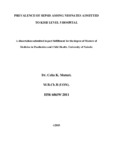| dc.contributor.author | Muturi, Celia K | |
| dc.date.accessioned | 2016-04-27T08:03:38Z | |
| dc.date.available | 2016-04-27T08:03:38Z | |
| dc.date.issued | 2015 | |
| dc.identifier.uri | http://hdl.handle.net/11295/95125 | |
| dc.description.abstract | BACKGROUND
Neonatal sepsis is the systemic inflammatory response syndrome in the presence of or as a
result of suspected or proven infection during the first 28 days of life (18).Neonatal sepsis is
the third most common cause of death in the neonate, contributing 10- 20% of deaths in this
age group, most of which occur in resource limited countries like Kenya. In Kenya, the
current neonatal mortality rate is 31 per 1000 live births. This study sought to determine the
burden of neonatal sepsis at Kisii level 5 hospital as well as the causative organisms and
pattern of antibiotic susceptibility, so as to allow appropriate treatment of neonates with
sepsis.
OBJECTIVES
To determine the prevalence of sepsis among neonates admitted to Kisii Level 5 hospital as
well as the pattern of bacterial causes of sepsis and the socio-demographic and economic
factors associated with neonatal sepsis.
METHODS
The baseline population was made up of neonates who displayed the clinical criteria that
form part of the definition of suspected neonatal sepsis. A questionnaire was administered to
consenting mothers and blood samples were taken for full haemogram and culture.
ANALYSIS
Data was entered into a Microsoft Access database with inbuilt consistency and validation
checks and was cleaned and stored. Analysis was done using SPSS analytical package. Data
was presented as tables and graphs. The prevalence of neonatal sepsis was calculated as a
xii
proportion of total neonates admitted over the study period. Data on neonatal characteristics,
maternal characteristics, delivery data and post delivery neonatal care was analyzed for
association with neonatal sepsis using chi square test and Fischer test where values were less
than 5.
RESULTS
After assessing 406 neonates, 80 neonates met the inclusion criteria for the study. The
prevalence of clinical sepsis was 19.7%. All the blood cultures undertaken in the study were
negative. There was therefore a significant reliance on the Haematological Score as described
by Rodwell et al to make inferences about the laboratory results of the recruited neonates (22).
Fifty one percent of mothers of neonates with highly likely or possible sepsis were
housewives and 67.8% had a secondary level of education. Eighty seven percent of mothers
were aged between 20 years to 30 years. Neonatal sepsis was significantly associated with
maternal dysuria. The mothers lived under more affluent conditions as indicated by 68.8%
living in stone or brick built houses.
CONCLUSION
Neonatal sepsis contributes significant proportion of neonatal admissions to Kisii Level 5
Hospital. Careful clinical evaluation of each admitted neonate for danger signs of neonatal
sepsis is required to facilitate prompt laboratory evaluation for confirm of the same and
commencement of antimicrobial therapy. | en_US |
| dc.language.iso | en | en_US |
| dc.publisher | University of Nairobi | en_US |
| dc.rights | Attribution-NonCommercial-NoDerivs 3.0 United States | * |
| dc.rights.uri | http://creativecommons.org/licenses/by-nc-nd/3.0/us/ | * |
| dc.title | Prevalence of sepsis among neonates admitted to Kisii level 5 hospital | en_US |
| dc.type | Thesis | en_US |
| dc.description.department | a
Department of Psychiatry, University of Nairobi, ; bDepartment of Mental Health, School of Medicine,
Moi University, Eldoret, Kenya | |



